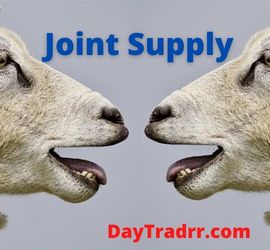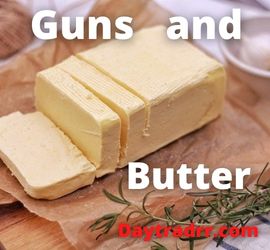What Is Joint Supply?
 Joint supply results when multiple products are derived from the same source and at the same expense. For example, when sheep are being raised for wool and meat.
Joint supply results when multiple products are derived from the same source and at the same expense. For example, when sheep are being raised for wool and meat.
A product or process that can provide two or more outputs is referred to as joint supply in economic terms. It usually occurs when two items are inextricably linked and produced from the same raw material or source. For example, cows can be used for milk, beef, and hide, from the livestock industry. Sheep can be used to provide meat, milk, wool, and sheepskin. As the supply of one of the goods increases or decreases, the supply of the other good either increases or decreases at the same time. For example, the availability of dairy and beef products will increase as the supply of cows increases.
In economics, the term refers to all goods that have dual usage. As the supply of a commodity rises, so does the supply of dual service for that product. For instance, gasoline, lubricants, paraffin, and chemical bases for plastics are produced during the crude oil refining process. As the availability of crude oil increases, so does the supply of gasoline, lubricants, paraffin, and other similar products.
Joint Supply – Why is it Important?
When there is joint supply, each product’s supply and demand are linked to the others that come from the same source. For example, if demand for wool rises and sheep farmers respond by raising more animals for wool, sheepmeat output will rise in tandem. As a result of the increased production, there will be more meat available. However, the increased supply of meat could result in reduced prices.
- Managing the output – In some instances, such as with cotton and cottonseed, the proportions of the joint products are nearly constant. As a result, proportions are unchangeable so increasing one automatically increases the other. However, the proportion can potentially be changeable in other instances. It is feasible, for example, to produce sheep for either wool or meat through cross-breeding. As a result, the quantity of one can be increased to some extent at the expense of the other. Analysts keep a careful eye on joint supply items because what happens with one can have a big impact on what happens with the other.
- Accounting for expenses – The allocation of expenses is another key issue with joint supply items. Because both items come from the same source, it can be difficult to figure out how to split costs. In the event of two items, splitting expenses down the middle is usually not possible. This is because one product usually sells at a higher price than the other. An equal split will artificially deflate profits on one product while artificially inflating profits on the other. Similarly, assigning spending at random will yield fictitious results. On the business side, price matrices that move backward from the end goods to establish costing for reporting purposes are commonly used.
Managing Joint Supply
Managing joint supply is often not straightforward in the real world. Demand and supply are linked to other products from the same source in a joint supply. For example, if you want to enhance wheat yield, you’ll automatically increase straw production as well. Cotton and cottonseed production, mutton and wool production, gas and coke production, beef and hide production, and so on are all examples of this. The question is how the market determines each product’s pricing.
Products with variable proportions
The marginal cost of each product can be determined independently in the case of items with varying proportions. Crossbreeding sheep in Australia and New Zealand, for example, has resulted in different quantities of wool and mutton. A sheep breed that produces more mutton but less wool, or less mutton but more wool, depending on the situation. The marginal cost of each product’s output can be determined. It assumes that the amount of one commodity remains constant while the quantity of the other increases. Thus, the goods become differentiated when applying marginal analysis to assess the marginal cost of production.
Products with Non-variable Proportions
However, the proportions of some types of commodities are set. Therefore, increasing the production of one commodity necessarily results in an increase in the supply of the other. If the price of cotton rises and the amount of cotton produced rises, the total quantity of cottonseed will also climb. In such circumstances, it is impossible to isolate the marginal cost of a commodity by increasing its production independently.
Joint Demand
Demand isn’t necessarily related to joint supply and the two terms are not directly related. Joint demand happens when the demand for two goods is interdependent. For example, printers need ink to function. conversely, ink cartridges are of no use without a printer. Other examples could be razors and razor blades, or gasoline and motor oil. As you can see, joint demand has little to do with joint supply.
Joint Supply – Benefits and Risks
Most of the time, joint supply can provide cost savings, price reductions, or charitable opportunities.
Advantages
- Increased profit potential – Due to the two-fold increase in supply, there is a two-fold increase in profit.
- Benefits the overall economy – The more joint supply goods available in an economy, the better the prospects of it doing well. Dual-use resources are limited, but any economy will make significant progress if these resources are made unrestricted.
- Stable pricing – Price discrimination is more difficult in joint supply because supply must be calculated based on both supply forms.
Disadvantages
- Difficult to manage proportions – The proportions of joint goods are often nearly set. Therefore, the quantity of one product may increase at the expense of the other product. For example, if a sheep farmer responds to market demand for mutton, he will simultaneously flood the market for wool. The wool might not be in particular demand, so the additional supply will drive wool prices down. Analysts keep a close eye on products in joint supply because investments in one can be significantly impacted by what happens with the other.
- Managing expenses – The distribution of expenditures is another issue with joint supply goods. Since both goods are produced from the same source, it can be challenging to find out how to split expenses.
- Proper accounting – In the case of two goods, splitting costs down the middle usually is not possible since one product usually sells at a higher price than the other. An equal split will artificially deflate or inflate profits on one product or the other. Likewise, randomly allocating expenses will produce artificial results.
(Sources: investopedia.com & kalkinemedia.com)
Up Next: What Is the Posted Date?
 For credit and debit cards, the posted date is the specific day, month, and year on which a card issuer posts a transaction and adds it to the account balance of the cardholder. For a bank, it is the day on which money is taken out of or deposited into a bank account. The posted date, also known as the settlement date, can be the same day as the transaction date.
For credit and debit cards, the posted date is the specific day, month, and year on which a card issuer posts a transaction and adds it to the account balance of the cardholder. For a bank, it is the day on which money is taken out of or deposited into a bank account. The posted date, also known as the settlement date, can be the same day as the transaction date.
However, in practice, the post date is usually one to three days later. The float is the time between the transaction date and the post date. Electronic payments frequently include contact with many parties. As a result, this might delay the posting of a transaction. Banks have procedures in place to assist account holders in managing their account balances between the time when a transaction occurs and when it is posted or settled.
The issuing bank will normally place funds on hold once a transaction has been approved. This will reduce the available credit balance by the purchase amount for a credit card transaction. The account holder’s available funds will be reduced as a result of a debit card transaction. The account holder will often see the transaction displayed as a “pending transaction” for both debit and credit card accounts. The post date will be used by most issuing banks as the last date on an account holder’s monthly statement.




